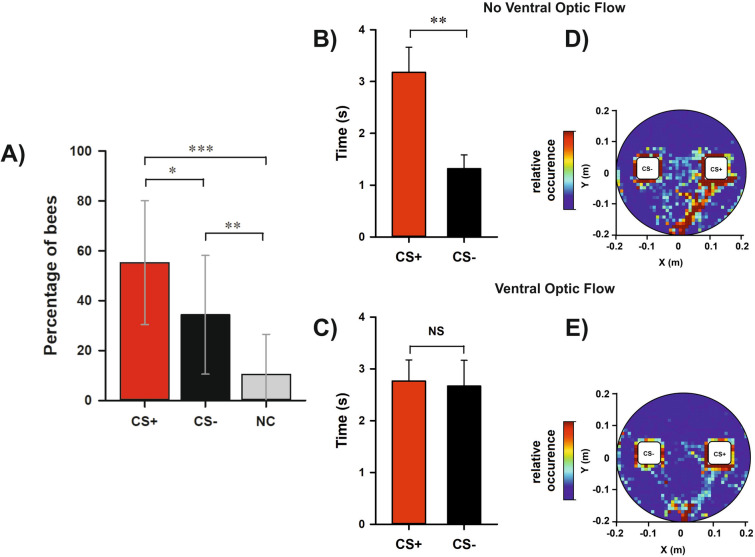Figure 9.
Test performances (1st choice and fixation time) in a color discrimination learning task under two different ventral optic-flow conditions (with ventral optic flow and without ventral optic flow). (A) 1st choice performed during the test. As there were neither significant differences between the two ventral optic-flow conditions nor between the color conditions (blue or green rewarded), results were pooled and presented as a single bar diagram (N = 67). The graph shows the percentage of bees responding to the CS+ (red), to the CS− (black) or not making any choice (NC; gray) during the retention test. Error bars indicate 95% confidence intervals. *: p < 0.05; **: p < 0.01; ***: p < 0.001. (B, C) Fixation time during the test in the ‘No Ventral Optic Flow Condition’ and in the ‘Ventral Optic Flow Condition’, respectively. In this case, fixation times were separated according to the experimental condition, as different response patterns were observed with and without ventral optic flow. The graphs show the mean time (± S.E.) spent fixating either the CS+ or the CS− during the retention test. (B) In the ‘No Ventral Optic Flow Condition’, bees fixated significantly longer the CS+ than the CS−. **: p < 0.01. (C) In the ‘Ventral Optic Flow Condition’, bees fixated equally the CS+ and the CS−. NS: not significant. (D, E) Heat maps showing the cumulative coordinates occupied by the bees during the test in the ‘No Ventral Optic Flow Condition’ and in the ‘Ventral Optic Flow Condition’, respectively. The CS+ is shown on the right by convention. Coordinates were binned into 1 cm2. Warmer colors depict locations more frequently occupied (see color bar). The highest frequency is cut down to 10% of the maximum on the color bar. (D) In the ‘No Ventral Optic Flow Condition’, bees clearly aimed at the CS+ besides choosing it more frequently in their first choice. (E) In the ‘Ventral Optic Flow Condition’, bees also aimed at the CS+ but in a less clear way.

